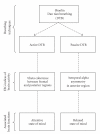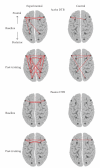Shaolin dan tian breathing fosters relaxed and attentive mind: a randomized controlled neuro-electrophysiological study
- PMID: 20976126
- PMCID: PMC2957109
- DOI: 10.1155/2011/180704
Shaolin dan tian breathing fosters relaxed and attentive mind: a randomized controlled neuro-electrophysiological study
Abstract
Neuro-electrophysiological studies on meditative breathing revealed its association with either a relaxed or an attentive state. The present study aimed to investigate whether the Shaolin Dan Tian Breathing (DTB) technique, which consists of the Passive and Active subtypes and can be considered as a relaxation exercise and Qigong, would induce both relaxed and attentive states. Twenty-two adults and 22 age-, gender- and education-matched controls received training on the Shaolin DTB (experimental group) and the progressive muscle relaxation respectively for one month. Eyes-closed resting EEG data before and immediately after each type of breathing were obtained individually at baseline and after one-month training. At baseline, the EEG changes after the Shaolin DTB between both groups were comparable. After one-month training, participants in the experimental, but not the control, group showed enhanced temporal alpha asymmetry (an index of relaxation and positive mood) after performing the Passive DTB for five minutes, and enhanced intra- and inter-hemispheric theta coherence (an index of attention and alertness) after performing the Active DTB. The present findings suggested a positive effect of the Shaolin DTB technique on enhancing human neural activity and connectivity, which may possibly enhance mood state and cognitive functions.
Figures




References
-
- Nakao M, Fricchione G, Myers P, Zuttermeister PC, Barsky AJ, Benson H. Depression and education as predicting factors for completion of a behavioral medicine intervention in a mind/body medicine clinic. Behavioral Medicine. 2001;26(4):177–184. - PubMed
-
- Tsang HWH, Cheung L, Lak DCC. Qigong as a psychosocial intervention for depressed elderly with chronic physical illnesses. International Journal of Geriatric Psychiatry. 2002;17(12):1146–1154. - PubMed
-
- Deckro GR, Ballinger KM, Hoyt M, et al. The evaluation of a mind/body intervention to reduce psychological distress and perceived stress in college students. Journal of American College Health. 2002;50(6):281–287. - PubMed
-
- Schwartz JM, Begley S. The Mind and the Brain. Neuroplasticity and the Power of Mental Force. New York, NY, USA: Regan Books; 2002.
LinkOut - more resources
Full Text Sources
Medical
Miscellaneous

